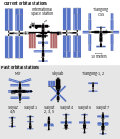Skylab II
 Artist's conception of the Orion Multi-Purpose Crew Vehicle docking with a module of the proposed Skylab II. Credit: NASA/Advanced Concepts Office | |
| Station statistics | |
|---|---|
| Crew | 4 |
| Launch | after 2021 |
| Carrier rocket | Space Launch System |
| Mission status | Proposed |
| Mass | 37,300 kilograms (82,200 lb)[1] |
| Length | 11.15 meters (36.6 ft) |
| Diameter | 8.5 meters (28 ft) |
| Pressurised volume | 495 cubic meters (17,500 cu ft) |
| Periapsis altitude | 443,000 kilometers (239,000 nmi) (approx.) |
| Orbital inclination | 5.145° to the ecliptic |
| Orbital period | |
Skylab II is a space station concept proposed in 2013 by the Advanced Concepts Office of NASA Marshall Space Flight Center, to be located at the Earth-Moon L2 Lagrangian point.[3] Proposed by NASA contractor Brand Griffin, Skylab II would be constructed as a "dry workshop" using the upper-stage hydrogen fuel tank from the Space Launch System (SLS), much as the original Skylab was built from the fuel tanks of the Saturn S-IVB upper stage.[3] If constructed, Skylab II would be the first crewed outpost located beyond the orbit of the Moon.[4]
Space station design
Skylab II would be parked near the Earth-Moon L2 point, which revolves around the Earth at an approximate mean distance of 443,000 kilometers (239,000 nmi) from the surface, and stays approximately 62,800 kilometers (33,900 nmi) beyond the far surface of the Moon.[5] Given its location far away from the nearest food, water, and air, the first iteration of the space station would be able to support a four-person crew for 60 days on one shipment of supplies, to be eventually improved to 180 days.[1] As Skylab II would be built from an SLS hydrogen fuel tank, the costs of assembly would be a relatively low $2 billion, a tremendous savings over a previously projected cost of $4.175 billion for a similar space station.[1]

Credit: NASA/Advanced Concepts Office
The space station would have large modules with diameters of 8.5 meters (28 ft)—much larger than the 4.5-meter (15 ft) diameter of International Space Station modules or the 6.7-meter (22 ft) diameter of the original Skylab.[4] This large diameter would lead to a module volume of about 495 cubic meters (17,500 cu ft), allowing for a large amount of space for both storage and habitation.[4] This large interior volume, in turn, would make Skylab II suitable for its deep-space location, where resupply missions would be rare and astronauts would have to store the food they received from each mission for months at a time.[3] The supplies themselves could be carried in a variety of vehicles, such as the existing Progress and Dragon, or perhaps a new, SLS-derived logistics module, which could resupply the whole station in one mission.[1]
Potential uses
Once at Earth-Moon L2, Skylab II could be a "stepping stone" for further human exploration in the Solar System,[1] for example by being a docking site for a crewed lunar lander before the trip to the Moon.[1] The second use would be to add a servicing capability for the astrophysics missions located near Earth-Sun L2, extending the cryogenic mission lifetime of such missions by continually refilling their liquid helium and enabling some astrophysics missions which may otherwise have not been possible or would have been launched in a less-capable state.[1]
For extravehicular activities (EVAs) near the space station, a small, one-person FlexCraft may be used in lieu of a spacesuit to improve dexterity and safety for astronauts, as well as the efficiency of EVAs.[1][6] FlexCraft would eliminate the requirement of an astronaut to prebreathe the pure oxygen atmosphere in a spacesuit, reducing overhead time for EVAs significantly and enabling longer EVAs to be carried out.[6] Additionally, FlexCraft would improve astronaut speed during EVAs, as moving around space installations would be faster and less physically demanding in automated vehicles.[6]
References
- ^ a b c d e f g h Griffin, Brand (March 27, 2013). "Skylab II: Making a Deep Space Habitat from a Space Launch System Propellant Tank" (PDF). Future In-Space Operations Colloquium. Future In-Space Operations Working Group. Retrieved April 16, 2013.
- ^ Wieczorek, M.; et al. (2006). "The constitution and structure of the lunar interior". Reviews in Mineralogy and Geochemistry. 60 (1): 221–364. doi:10.2138/rmg.2006.60.3.
- ^ a b c Hammonds, Markus (April 14, 2013). "Skylab II: Living Beyond the Dark Side of the Moon". Discovery News. Discovery Communications LLC. Retrieved April 15, 2013.
- ^ a b c Wall, Mike (April 2, 2013). "NASA Mega-Rocket Could Lead to Skylab 2 Deep Space Station". Space.com. TechMediaNetwork. Retrieved April 15, 2013.
- ^ Dunn, Tony (2008). "Lagrange Point Calculator". Gravity Simulator. Retrieved April 16, 2013.
- ^ a b c Griffin, Brand (August 13, 2012). "Benefits of a Single-Person Spacecraft for Weightless Operations" (PDF). Future In-Space Operations Colloquium. Future In-Space Operations Working Group. Retrieved April 16, 2013.

